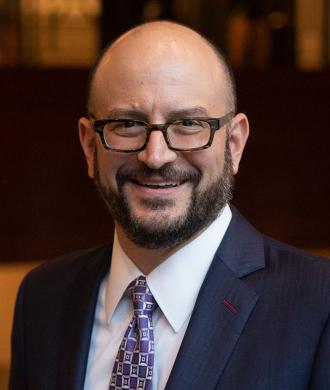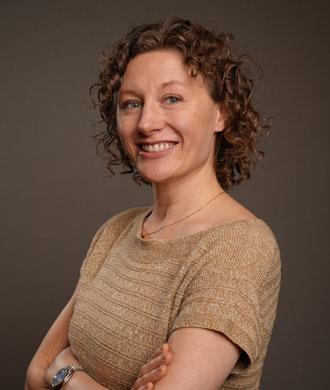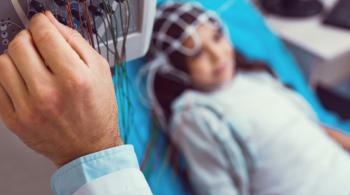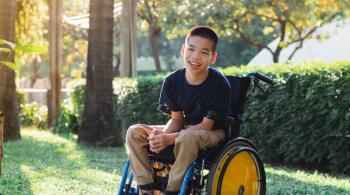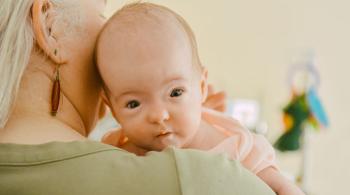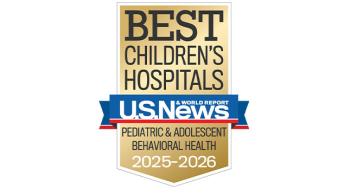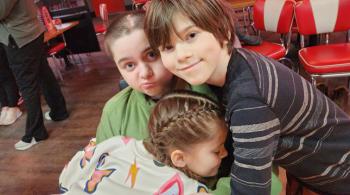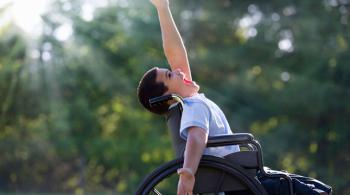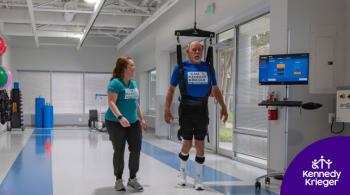Cerebral Palsy
People with disabilities or chronic health conditions, such as cerebral palsy, may be as much as 3-4 times more likely to develop depression and anxiety disorders. Research suggests this link is not necessarily related to the severity of a person’s disability but is instead tied to things like levels of stress, management of pain and fatigue, coping skills, or family and social support.
In this episode of Your Child’s Brain, Dr. Brad Schlaggar, president and CEO of Kennedy Krieger, is joined by two of his colleagues: Dr. Heather Riordan, a child neurologist and medical director of the Phelps Center for Cerebral Palsy and Dr. Aaron Hauptman, a pediatric and adult neuropsychiatrist, and the associate director of Neuropsychiatry to discuss cerebral palsy with a special emphasis on the mental health challenges with the disorder.
Related Links:
Learn More About Our Featured Speakers
Learn More About Our Featured Speakers
View Episode Transcription
Ad: Support for WYPR's live stream comes from Gilman hosting their seventh annual Cars, Trucks, and Things that Go event featuring monster trucks, community helper vehicles, classic cars, circus acts, a live DJ and more, Saturday, October 21st, from 09:00 to 11:00 AM. To register for this free event, Gilman.edu/Visit.
Dr. Brad Schlaggar (BS): Welcome to Your Child's Brain, a podcast series produced by Kennedy Krieger Institute with assistance from WYPR. I'm Dr. Brad Schlaggar, pediatric neurologist and president and CEO of Kennedy Krieger Institute. In today's episode, we will discuss cerebral palsy with a particular focus on mental health issues faced by patients with cerebral palsy. First, a bit of history. Cerebral palsy is an old term in medicine. Cerebral means the brain and palsy means weakness. Cerebral palsy then is intended to refer to weakness, or more broadly, issues with voluntary movement that stem from a problem or problems in the developing brain. The term cerebral palsy was first coined in 1887 by Dr. William Osler, just two years before he moved from Philadelphia to Baltimore to become the very first physician in chief at the Johns Hopkins Hospital in 1889, the year of its founding. Several years later, Osler was instrumental in the establishment of the Johns Hopkins University School of Medicine where a generation later, Dr. Winthrop Phelps completed his medical degree in 1920 and initially trained at Johns Hopkins Hospital and Baltimore Children's Hospital in pediatric medicine before heading to Harvard for further training in orthopedic surgery. Dr. Phelps became very interested in understanding how to help children with movement problems that arose after early brain injury, namely cerebral palsy. This interest brought him back to Baltimore in 1936, where he set up a practice for the treatment and rehabilitation of children with cerebral palsy. In the following year, 1937, he founded the Children's Rehabilitation Institute. He not only brought an interdisciplinary and often non-surgical approach to cerebral palsy, he also trained clinicians and helped to set up cerebral palsy programs elsewhere. Dr. Phelps's Children's Rehabilitation Institute is the forbearer of the present day Kennedy Krieger Institute, having merged in 1967 with the then newly established John F. Kennedy Institute for Rehabilitation of the Mentally and Physically Handicapped Child in East Baltimore, adjacent to the Johns Hopkins Medical School Campus. Indeed, to this day, we at Kennedy Krieger honor Dr. Phelps' legacy with the Phelps Center for Cerebral Palsy at Kennedy Krieger Institute. The idea that significant mental health issues are not only common in children with neurodevelopmental disorders, but they also can appear clinically different in important ways when compared to children who are typically developing. That idea also is a Baltimore, Kennedy Krieger, Johns Hopkins Medicine story. As our first director of psychiatry at Kennedy Krieger, the late Dr. Jim Harris, who also directed Child and Adolescent Psychiatry at Johns Hopkins, founded the field of developmental neuropsychiatry roughly 40 years ago, a legacy that we fully embrace through neuropsychiatric clinical care and we disseminate through research and clinical training. I'm excited to be joined today by two of my exceptional colleagues from Kennedy Krieger Institute. Dr. Heather Riordan, a child neurologist, is the medical director of the Phelps Center for Cerebral Palsy at Kennedy Krieger. She's also an assistant professor in the Department of Neurology at the Johns Hopkins University School of Medicine. Dr. Aaron Hauptman, a pediatric and adult neuropsychiatrist, is the associate director of Neuropsychiatry at Kennedy Krieger Institute, and he is an assistant professor in the Department of Psychiatry and Behavioral Science at Johns Hopkins University School of Medicine. Welcome Heather and Aaron. Let's start out with you Heather. I'd said a bit about the term cerebral palsy, but let's get into some details. What is it, why is it called cerebral palsy? What is the incidence rate? Are things getting better? Are the numbers going up or down?
Dr. Heather Riordan (HR): As you mentioned earlier, the term cerebral palsy is actually quite old, although we have tried to refine the definition over time. At this point, cerebral palsy is defined as something that started in the infant brain, so really sometime before the child turned two, that is, non-progressive, meaning there are more problems with the brain that are developing over time, more damage or abnormalities and that affects movement and posture. I think it's important when we talk about this to realize that that's a very broad definition and it says nothing about why an individual might have cerebral palsy. There are actually many different causes of cerebral palsy. In the US, currently, it is estimated that between 2-3 and 1,000 children are born each year with cerebral palsy. It sounds like not a lot, but when you compare that to other childhood illnesses, for example, childhood cancer, it's 10 times more common than childhood cancer, it's five times more common than the relatively common genetic disorders like cystic fibrosis. It is actually quite a prominent problem within our society. There is some evidence that there may be some hope on the horizon with some slight improvements in the rates of cerebral palsy over the last few years with changes in the NICU but these changes are very slight and we need to do better.
BS: You mentioned that there are multiple causes of cerebral palsy. Can we get into that? What causes are there? Are there factors that increase the likelihood of a diagnosis of cerebral palsy?
HR: I think one of the myths around cerebral palsy is that it is always due to something that an obstetrician did wrong. There's a lot of evidence that shows that in the vast majority of kids, cerebral palsy is due to something that started even before a child was born. We do know that there are some risk factors such as prematurity, infection, brain bleeds, things like that early in life. We also know that there are some classic findings that we see on MRI in most children with cerebral palsy, but not all. Classically cerebral palsy has been thought of as injury to the developing brain in the mylination or insulation that exists around the individual neuron, similar to the plastic that exists around wires in our electronics. But more and more, we're realizing that it's not that simple. Like most things in life, 20% of people with cerebral palsy action have completely normal MRIs and no signs of that type of damage. We now know that up to 35% of people with cerebral palsy have a primary genetic cause when we're doing deep genetic testing. I suspect that as we get more information and do more studies, we're going to find that many more people have either a primary genetic cause of their cerebral palsy or genetic factors that combine with their other risk factors to result in the cerebral palsy picture.
BS: Yeah, that combination of genetic factors with perhaps some environmental effect is really important for us to work through as the complex etiology of cerebral palsy and other neurodevelopmental disorders. CP, as we talked about cerebral palsy, sometimes I'll say CP is really defined as a motor system problem, but what you've just been describing, it can be a brain wide issue. What are some of the other functions of the brain that are implicated, like sensation or intellectual function, emotional, effective function, executive function, and so on?
HR: The term cerebral palsy is defined by the motor symptoms. There are many people with cerebral palsy who don't have other co-occurring neurological conditions. But because these abnormalities in the brain can affect areas that also lead to other neurological symptoms, we do see a lot of different things that can present in these patients. Up to half of patients with cerebral palsy will have intellectual disability and up to a quarter of them will have epilepsy. Similarly, ADHD or specific learning disabilities may be common even for those who have normal intelligence or above normal intelligence. It's really important in our higher functioning individuals with cerebral palsy that we're keeping our eyes out for this, that we can make sure we're supporting them appropriately as they're going through school and even entering the college environment.
BS: In terms of the way cerebral palsy appears clinically, are there gradations or different types? What are some of the motor system signs and symptoms in individuals with cerebral palsy that may delineate the different ways that they can present in terms of motor function?
HR: I'm going to borrow a quote from the autism world right now which goes, if you've met one person with cerebral palsy, you know one person with cerebral palsy, and I think that's important. Many people have some picture in their mind from somebody that they may have known in high school or somewhere else and not realize how diverse the different symptoms and presentations of this condition can be. In terms of severity, we have many people in our community that we are in contact with that come to our clinics who are lawyers or doctors or have really important government positions. If you look at them you might notice a little difference in their limp or a little bit of difference in their arm, but it's relatively subtle. You also have children or individuals who have difficulty completing any of their motor tasks independently, like dressing or bathing, or things like that. Similarly, there's a gradiation in the types of motor symptoms that you can have. This depends very much on what parts of the brain are involved with the underlying cause of the cerebral palsy. The most common symptom we see is something called spasticity which is a motor stiffness, particularly if you're moving the muscles quickly. The second most common is something called dyskinetic cerebral palsy, which is basically where the body has extra movements that it does on their own that are involuntary. The third type of cerebral palsy is ataxic cerebral palsy, which is basically difficulty coordinating movement similar to what would happen if somebody indulged in too much alcohol. We used to say that the vast majority of people had spasticity and spasticity alone, but some more recent studies from Australia show that over half of people actually have a mixture, where they have some of those dyskinetic symptoms as well as the spastic symptoms. That's really important in guiding treatments. Since there may be treatments that really only work for one or the other. It opens avenues for more options.
BS: Heather, you mentioned earlier that part of the cerebral palsy concept is that it's non progressive. Something happens early on and there's no further damage to the nervous system, therefore it's a non progressive condition by definition. But clinically, do you see patients who do progress despite the fact that the definition says that they're not supposed to?
HR: The definition when they say that cerebral palsy is non progressive is really referring to the disorder dysfunction that's happening in the brain itself. Unfortunately, cerebral palsy can be hard on the body. That combined with the natural wear and tear of aging, can produce worsening motor abilities or function over time where people who had been able to walk independently may have difficulty due to worsening muscle tightness over time or increased pain, hip problems, back problems, things like that.
BS: Mentioned earlier also that for example, I think you said not all children with cerebral palsy. It's because of something that somebody did wrong. That's addressing one of the myths that are out there about cerebral palsy. What are some of the other myths that need to be corrected regarding the mechanism leading to cerebral palsy or about people living with cerebral palsy?
HR: First, I'd like to follow up on your comment that cerebral palsy isn't something that somebody did wrong. While not a common myth in the community, many parents feel some guilt or weight that their child's cerebral palsy was due to something they did wrong or some sort of insufficiency to their pregnancy and their own body. I think it's really important to acknowledge that that's not the case, and that typically these are things that could not have been prevented by actions on the parents. One of the other big myths that our patients deal with is assumptions about their cognitive ability. A lot of people are quick to make assumptions based on the way somebody talks or the way somebody moves about what they understand. I have many patients who have significant difficulty with their movements to the point that they have difficulty talking and being understood, and yet are actually quite bright, have beautiful ideas, and things that they want to share. I think not making assumptions about somebody when you first meet them is really important. Other things that we commonly see are assumptions that all people with cerebral palsy have poor quality of life. There are a lot of studies that show that overall, the quality of life, while people may struggle more with tasks being more challenging or pain or things like that, it's actually pretty high. The biggest predictor of quality of life, or one of the biggest predictors is actually social engagement and peer engagement. That's particularly true for people who are in the school setting. One of the most important things we can do is to engage and welcome people of all abilities into these different social arenas so that they can have those experiences and enjoy just being a typical human.
BS: Heather, one of my colleagues in training, somebody that I think you know from the child neurology world that preceded you in your training days. Dr. Jan Brunstrom, a child neurologist, who herself has cerebral palsy. The power of her presence for families to see that their child could, for example, grow up to be a physician, a child neurologist. The impact that that had just by that representation was so important for the mindset that families had for the long haul that was in front of them, for making sure that their child had every opportunity to interact with all avenues in front of them. Your point about seeing from that perspective, it's really key and I wanted to emphasize that. In terms of interventions, what treatments are currently used to improve quality of life and function for individuals with cerebral palsy? Are there medications? Are there surgeries? Are there different therapies?
HR: Typically, I divide the types of interventions we use for cerebral palsy into five different groups. The first and most important is therapies. Relationship with a physical or occupational or speech therapist is vital in terms of helping a child meet their own individual potential. In terms of things that the doctors do, there are medications, there are injected medications and then there are surgeries. We have many medicines that can be given by mouth or by G tube if needed, that can help to relax muscles or address some of the abnormal neuronal firing. Botulinum toxin and the various subsidiaries are commonly used to help decrease muscle tightness for people with cerebral palsy. Although there is a growing body of evidence that we need to look at the risks versus benefits of those types of procedures more than we had previously. Then there are two big categories of surgeries. One are orthopedic surgeries, which are meant to correct the bony problems that can develop over time as a result of cerebral palsy. There are some neurosurgical procedures that for the right patient, can be helpful and those include everything from medication pumps that deliver muscle relaxants next to the spinal cord, to surgeries where you break these aberrant reflex arcs that are telling your body to tighten every time those muscles are stretched as a way of decreasing tone in the legs.
BS: You touched on this a bit, but there are other non-neurologic health issues that can come along with cerebral palsy that involve multiple different systems. Can you take us through some of those?
HR: You may remember that I said earlier that there are five different ways we treat cerebral palsy. I only mentioned four. That's because the fifth is addressing those co-occurring conditions that occur and that can have really complex interactions with tone. For example, if you're having pain that can make your muscle tightness worse. Outside of the neurological conditions that we discussed earlier, there are a lot of orthopedic challenges that these individuals can have. Scoliosis is very common. Hip problems, including full hip dislocations, are fairly common to the point that there are guidelines about making sure we're getting regular X-rays on these individuals as they're growing because they're not putting the same normal weight on their bones. Osteoporosis at a premature age is very common. I've seen many people come in who've had spontaneous fractures that we happen to pick up on in clinic where somebody is upset or having pain somewhere, and we find out that they broke one of their bones or even their femurs during their normal routine cares. Similarly, we pay a lot of attention to vision, hearing, GI problems, lung problems, all of these different systems that we discuss about. Increasingly and part of the reason we're meeting today, we're learning that there are increased risks for things like depression, anxiety, and even other more complex psychiatric conditions that these people face, which again have complicated interactions on their general physical health.
BS: Cerebral palsy, again defined by the motor system, the historical definition, but as you've just laid out, so many other nervous system manifestations and non-neurological, including the consequences of having a chronic condition, so all conspiring. It just makes sense that there would be adjacent mental health issues. Aaron, thanks for waiting so patiently to get into the conversation, but let's start talking about the mental health issues in individuals with cerebral palsy from a neuropsychiatry perspective. How do you see, what do we know about mental health issues in CP? Where's the field going?
Dr. Aaron Hauptman (AH): I think it's a mixed bag. I think we don't know nearly enough and that is a huge hindrance. We still have a tendency to maybe prioritize, but certainly conceptualize CP from a much more motor-oriented perspective, which is of course crucial, but it means we don't have enough studies. The data that we've got is pretty limited, and I think we see a lot of challenges around identifying mental health diagnoses in individuals with CP. Even knowing how to study these things when people have challenges around communication or a really wide range of underlying causes for their cerebral palsy and manifestations, it makes research really difficult. The data that we've got suggests that mental health symptoms or psychiatric symptoms or formal diagnoses are really common. 20 to almost 60% of individuals with CP have psychiatric symptoms or would meet full criteria for psychiatric diagnoses. These are common across the lifespan. But shift, we tend to see more trouble with what are considered behavioral issues and ADHD, or executive function-driven issues in childhood that start to shift more towards anxiety and depression and those kind of diagnoses and symptoms later in life.
BS: How do you think about the risk factors for mental health concerns? Your point is very well taken that it's understudied, under-recognized. There's some challenges for that clinical recognition but from your perspective, how do you think about the risk factors for mental health concerns? Would those change, for example, with the child's age?
AH: Yeah. I think as with any condition affecting the brain that has psychiatric and behavioral manifestations, I think we have to think about a few different components of people's experience. I think there is the direct impact to the brain of whatever the underlying cause of somebody's cerebral palsy is. If that's a genetic condition or injury to the brain from oxygen being cut off or any of these things, those can very directly cause psychiatric manifestations. But then also secondary causes, so things like epilepsy that people may develop, or intellectual disability. These are independent risk factor for certain psychiatric diagnosis. For example, thinking about people who have epilepsy, which occurs quite commonly in folks who've got cerebral palsy. Epilepsy in and of itself is a major risk factor for depression, anxiety, ADHD, and these things. Beyond that, there are a lot of psychosocial factors. We see community involvement, activity level, things like bullying at schools. These all can significantly predispose one to things like depression and anxiety. Two additional factors would be things like pain, which is in and of itself a significant risk factor for particularly depression and anxiety but other things as well. We can see that as a predisposing factor for a lot of the behavioral challenges that can come about especially if somebody has either co-morbid intellectual disability or a communication disorder which is something that we see in over half of individuals with CP. If you're not able to express a source of discomfort or really clearly express bodily need, or medical problem that commonly can manifest with behavioral or other things that are considered psychiatric manifestations. Then finally, the impact on the family of raising a child with cerebral palsy or really any disability can be enormous, can affect the mental health of parents, can affect family dynamics, can affect resources that may be available to the family. All of those things together are a wide set of risks.
BS: Earlier we talked about how one of the principles that gave rise to developmental neuropsychiatry. This idea that the way mental health conditions show up in neurodevelopmental disorders may look different than in typically developing children. What do we know about that in terms of the way mental health issues show up in individuals with cerebral palsy? Is it different or is it too early in our investigation to know that to be the case?
AH: There's a lot to say about it. I think that any time that communication and the ability to express one's needs and bodily functions is impacted by a condition, it then results in delays to diagnosis, people putting up with and managing really severe medical issues without help until it becomes recognized. Very often what we see is somebody presenting with aggression, behavioral dysregulation, some functional decline, and that's the thing that brings them to psychiatric care. One of the real challenges, I think for a lot of individuals with CP is that by that point we're then trying to manage the behavioral symptoms. That becomes so much at the forefront of everybody's mind that we're not so much looking for the underlying causes. We're not looking as clearly for underlying depression or anxiety, or ADHD. We're just trying to tamp down a behavior that's making going to school difficult, or managing one's activities of daily living at home more difficult. Which is a challenge because the treatments for those challenges tend to be more sedating medications or medications that in and of themselves have lots of side effects, have their own risk factors, and can sometimes even worsen some of the underlying challenges. I think the classic thing that comes to mind is a little bit from older school psychiatry, but the idea of somebody coming in with aggression who's not able to communicate a particular need and then a clinician using an anti-psychotic medication to manage that, which then could interact with other medications worsen symptoms like constipation. Sometimes the underlying cause is just one of those things. Pain, gastrointestinal distress, those sorts of things. It can become a vicious cycle.
BS: Aaron, you mentioned a moment ago about how the impact on a family is really paramount to understand. How does having a family member with cerebral palsy or even other potentially serious or disabling conditions impact the mental health of the entire family?
AH: Having a child with a developmental disability really significantly impacts families. The lifetime cost of cerebral palsy is upwards towards $1 million. That's not including lost wages, other impacts on the family. It can be really challenging on the family structure. For parents of kids with intellectual disabilities more broadly, up to maybe around 30% of parents can have their own depression and that's compared with less than 7% of parents of kids who don't have a developmental disability. About 30% have their own anxiety disorders, compared with around 14%. Just across the board, even families who have equal education report lower incomes. There are greater rates of chronic illness in family members caring for an individual with intellectual disability or developmental disabilities. Just across the board, there are lots of chronic stressors on families with kids with CP alongside other developmental disabilities. I also maybe just to dovetail with that, another thing to just mention is that the risks of trauma and psychosocial stresses are higher on this population. This is something we always like to stress, especially when a child or an adult with CP comes in with new onset, psychiatric symptoms or behavioral symptoms that hadn't been reported before. We want to make very sure that we've ruled out something like a new traumatic event or some new significant psychosocial stressor because those can be so commonly the underlying cause for dramatic sudden changes. Especially if individuals have a communication disorder, it can be very difficult for them to advocate for themselves. I'm certainly not saying that this is the case for everybody. I don't want people to be frightened by hearing that. But it is something as clinicians, that we really try to keep in the forefront of our mind when somebody has significant dramatic new symptoms.
BS: I'm really glad you made that last point as well. The greater risk potentially for exposure to adverse childhood experiences and traumas, also that it's not a simple layering on or additional factor that the underlying neurodevelopmental condition in the context of those adverse experiences and traumas. It's not a one plus one equals two situation, so as clinicians, we need to be very much aware of that potential problematic interaction and to be aware of that increased risk for exposure. Excellent point. Aaron, what are some of the strategies that we can take for treating behavioral health issues in cerebral palsy? We talked about medications. But in addition to medication, perhaps inclusive of medication, what else is there?
AH: Well, this is one reason that I'm so excited to be here talking with Heather today because I think multidisciplinary care and communication between providers along with families, of course, is crucial to this. So often the medications that we prescribe may interact or features of somebody's movement disorder may contribute to anxiety or depression and vice versa. Really communication between providers about what they think is going on, especially when we can all be so siloed is really pivotal. Beyond that, we always emphasize really paying attention to communication needs first, the kind of intervention when you're talking about psychotherapy or occupational therapy, or speech therapy or so many other of our interventions. The things that we're going to be looking at are going to really depend significantly on a person's communication needs and abilities alongside other things like therapies that might benefit the family as a whole. Trying to address those things first and then find beyond like really doing a thorough job of diagnosing what's going on, what the underlying causes could be, pointing people to the right kind of therapeutic interventions is very important. I mentioned the team based approach. We think a lot about trying to peel off medications wherever we can or try if somebody is already on medications. Because some folks with cerebral palsy will come to us on long lists of medications to manage their different medical, neurological, and other needs. Where can we either try to remove medications in order to improve function, or where can we try to optimize a particular treatment so that it covers a few different categories of concern. If a medication can be helpful both with sleep and anxiety and then also maybe be helpful with GI symptoms, why not choose that rather than three separate medications.
BS: I got one last question for you both and I would like you both to chime in on the topic of exercise, whether exercise is beneficial for individuals with cerebral palsy. Heather.
HR: I think a lot of people are scared about somebody "breaking" when they're stressing their body, but there's a lot of good evidence for the importance of exercise, not only in terms of improving your muscle strength, your flexibility, and those things that are important there, but also in terms of preventing long term cardiovascular effects or osteoporosis which are some of those other health problems that we can all get if we're not in physical health. But I'll turn to Aaron because there's also a lot of really important psychosocial factors in evidence that's really important from mental health and quality of life standpoint.
AH: Yeah. Social engagement is so important and things like involvement in adaptive sports and increased levels of social activity and engagement can be really helpful, not only for physical but also for mental health.
HR: To dovetail on that, I had a patient come in who was so proud of himself because since his last visit he said he has started playing tennis and tee-ball and got to go wakeboarding. This is all in the setting of an adaptive sports environment. But it really had important impacts on his self esteem, his sense of self and accomplishment, and his ability to perceive himself in a world beyond the typical restrictive pattern that people will stereotypically put on people with cerebral palsy.
BS: I'm really glad you mentioned adaptive sports to say that. One of the things that we do here at Kennedy Krieger is a adaptive sports program called Bennett Blazers. It's a great venue for everything from recreational to elite athletic experience and it's with the same principles that you both just laid out in mind. Thank you to each of our guests, Doctors Heather Riordan and Aaron Hauptman. We hope that you, our listeners, have found the discussion informative and helpful. Please check out our entire library of topics on your child's brain at Wypr.org, KennedyKrieger.org, Wypr.org/studios, or wherever you get your podcasts. You've been listening to Your Child's Brain. Your Child's Brain is produced by Kennedy Krieger Institute with assistance from WYPR and producer Spencer Bryant. Please join us next time as we examine the mysteries of your child's brain.

